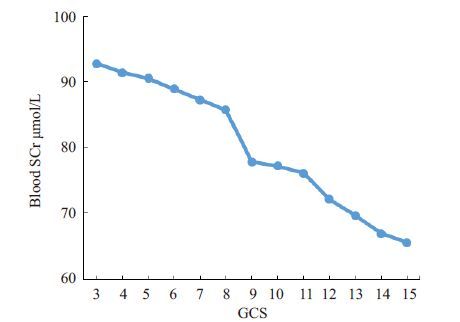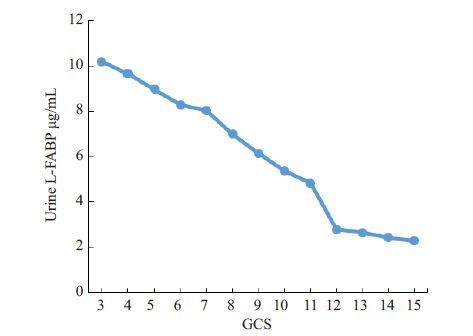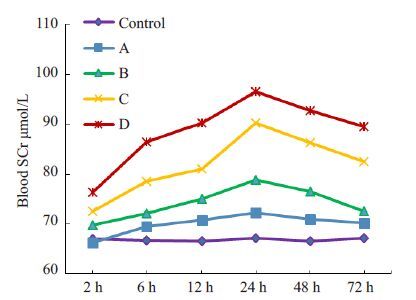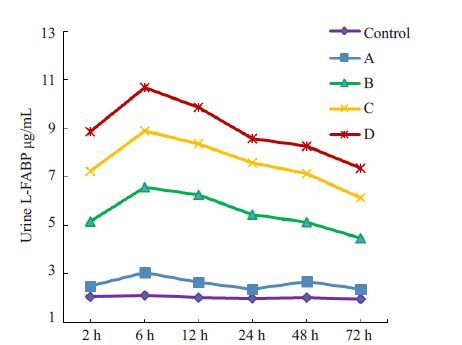急性颅脑外伤的临床致死率和致残率水平均较高,发病率亦呈明显增高的趋势,严重威胁患者的生命健康。颅脑外伤应激可导致全身多个系统功能受损,近年来严重创伤后急性肾损伤(AKI)发病率高达到50%,且死亡率高[1],尤其在重症监护病房(ICU)中病死率高达37%~76.19%,预后差[2-3]。外伤所致急性肾损伤逐渐被临床医师重视,处理不当将产生长期的严重的肾功能损害。早期诊断是前提和关键,选用准确的评价系统及时评估病情,发现AKI,对预后和治疗有重要意义。通常使用的判断早期肾功能变化指标有:中性粒细胞明胶酶相关脂质运载蛋白(NGAL)、白细胞介素-18(IL-18)、肾损伤分子-1(KIM-1)、Na+/H+交换体-3(NHE-3)、重组人富半胱氨酸蛋白-61(Cyr61)、N-乙酰-β-D-葡萄糖苷酶(NAG)、 胎球蛋白-A(Fetuin-A)等[4-5]。
GCS评分广泛应用于颅脑外伤的临床分型及伤情的评估,是评价和判断伤情、预后的指标,但评分也会受到一定的影响,如镇静剂、肌松剂、医师水平、观测条件、 生命体征不稳定等。近年来采用生化指标进行伤情判断及预测的研究较多,如反映中枢神经系统受损指标: S-100β、NSE、Tau等。这些指标难以同时在灵敏度和特异度上令人满意,目前多采用GCS评分结合多种生物标志物联合检测和判断。
肝型脂肪酸结合蛋白(L-FABP)是一类胞内分子蛋白,属于脂肪酸结合蛋白(fatty acid binding protein,FABPs)家族成员之一。L-FABP主要在肝脏表达,在肾脏近端小管也有表达,参与游离脂肪酸的胞内摄取、转运及氧化等多种代谢途径,是调节和维持游离脂肪酸在胞质内环境稳定的一个关键调节因子[6]。颅脑外伤所致人体内环境稳态的改变能否通过尿L-FABP表达显示出来,目前少有研究,本研究重点探讨早期的尿L-FABP检测对病情严重程度及AKI发生的应用价值,为临床治疗提供参考。
1 资料和方法 1.1 一般资料随机选取2014年5月~2015年10月中南大学湘雅三医院神经外科收治的不同GCS评分的颅脑外伤患者65 例,伤后3 d 均未进行开颅手术治疗,其中男性38 例,女性27例,年龄45.5±8.6岁,按GCS评分分为4 组[7-10],GCS评分13~15 分轻型颅脑外伤A组15 例,9~ 12分中型颅脑外伤B组20例,6~8分重型颅脑外伤C组15例,3~5分重型颅脑外伤D组15例,每个评分5例,并选取同时期健康志愿者为正常对照组(15例)。所有入选者均排除肝、肾功能不全等基础代谢性疾病病史,实验组和对照组对象分别于伤后2、6、12、24、48、72 h留取静脉血和中段干净尿标本。根据AKI临床实践指南中提出的AKI诊断标准进行定义:在48 h内,血清肌酐2 次升高绝对值≥26.5 μmol/L(或上升≥0.3 mg/dl)[11]。
1.2 标本采集和主要试剂收集健康志愿者和颅脑外伤患者起病后的清洁尿液20 mL 和外周静脉血液4 mL,离心后取上清液置-80 ℃冰箱保存待测,尿L-FABP采用酶联免疫吸附法(enzyme-linked immunosorbent assay,ELISA)检测,试剂盒购自美国RD公司,血清SCr检测送医院生化室,使用美国罗氏公司试剂和日立生化分析仪器,自动进行生化检测。
1.3 统计学方法采用SPSS 16.0统计学软件进行数据分析,计量资料数据采用均数±标准差来表示,多组间差异的比较采用单因素方差分析,组间差异性的比较采用LSD-T检验,以P<0.05为差异有统计学意义。
2 结果 2.1 血SCr结果根据表 1所示SCr的生化实验结果可以看出,实验A组患者SCr较正常对照组无明显增高(P>0.05),B组SCr较对照组增高,C、D组SCr较对照组增高更加明显(P<0.05);实验组间SCr水平差异比较均有统计学意义(P<0.05)。随着GCS评分的降低,血SCr 水平逐渐升高,呈现负相关性(P<0.05,图 1),表明病情越严重,血肌酐升高越明显,出现急性肾损伤患者越多。

|
图 1 血SCr与患者GCS评分关系 Figure 1 Relation between SCr level and GCS score. |
实验A组尿L-FABP水平较对照组无明显增高(P> 0.05,表 1),实验B组尿L-FABP较对照组增高,C、D组尿L-FABP水平较对照组增高更加明显(P<0.05),各实验组间尿L-FABP水平差异比较均有统计学意义(P< 0.05);随着患者GCS评分的降低(严重程度的增高),尿L-FABP水平逐渐增高,呈负相关性(P<0.05,图 2)。
| 表 1 实验组和对照组血SCr、尿L-FABP水平比较 Table 1 Comparison of SCr and urinary L-FABP levels in the case group and control group (Mean±SD) |

|
图 2 尿L-FABP与患者GCS评分关系 Figure 2 Relation between urinary L-FABP level and GCS score. |
根据SCr的检测结果和AKI的诊断标准,实验C组5例和D组9例患者出现AKI,发生率约21.54%;轻型与中型颅脑外伤A、B组未见AKI,重型颅脑外伤患者发生AKI 的比率较轻型与中型颅脑外伤明显增高。14 例AKI患者中1例出现在伤后6 h,5例出现在伤后12 h,8 例出现在伤后24 h。
2.4 血SCr与尿L-FABP水平变化的比较血SCr升高基本上发生在伤后12 h,高峰期集中在伤后24 h~48 h,诊断AKI时间在24 h 比较集中(见图 3);尿L-FABP水平在2 h时就有升高,高峰期出现在伤后6 h,24 h后逐渐下降(图 4),尿L-FABP升高与SCr升高呈正相关性;尿L-FABP升高较血SCr升高出现早,AKI患者的尿L-FABP水平升高时间点较SCr升高时间点提前更加明显;根据C、D组患者是否发生AKI分为两组进行尿L-FABP水平比较,AKI患者尿L-FABP值为:11.02±1.54 μg/mL,非AKI 患者尿L-FABP 值为: 8.63±0.85 μg/mL,AKI组尿L-FABP水平升高更加明显(P<0.05)。

|
图 3 不同时间点血SCr的变化情况 Figure 3 Changes of SCr level at different time points after the injury. |

|
图 4 不同时间点血尿L-FABP的变化情况 Figure 4 Changes of urinary L-FABP level at different time points after the injury. |
急性颅脑外伤是病情危重疾病,其发病率占全身创伤的第2位,而致残及致死率更居于首位[12-13]。早期病情判断是良好效果的前提和关键,准确地评估病情、发现AKI,对治疗和预后非常重要。以往的研究发现,患者血清心脏型脂肪酸结合蛋白(H-FABP)对于急性颅脑损伤患者早期诊断和预后判断具有一定的参考意义[14]。
本研究采用单一的生物标志物尿L-FABP进行检测来反应颅脑外伤损伤的严重程度,发现颅脑外伤B、 C、D组尿L-FABP水平较对照组明显升高,A组轻型颅脑外伤患者尿L-FABP水平升高不明显,随着患者GCS 评分的降低(病情严重程度的增高),尿L-FABP水平逐渐升高,两者呈负相关性(P<0.05),提示尿L-FABP可用于判断颅脑外伤的严重程度。进一步证实了尿L-FABP水平与颅脑外伤所致全身多处功能损害的密切关系,这可能与L-FABP在颅脑外伤中结合并转运长链脂肪酸,参与细胞内信号转导,抗氧化作用,调节细胞的生长与增殖密切相关,病情严重时机体维持稳态需分泌更多的L-FABP 来进行调节[15-17]。同时发现尿L-FABP水平在颅脑外伤后2 h时就有升高,高峰期出现在伤后6 h,24 h后逐渐下降,病情越严重出现升高的时间越早,尿L-FABP升高越明显,下降的时间晚,具体时间因为研究的时间不够长,无法准确地预知。因此尿L-FABP可以较早期预判颅脑外伤病情的严重程度,也符合国内外其他一些研究结果[16-18]。
目前临床通常使用血肌酐和尿量作为AKI诊断标准,然而这些指标影响因素众多,当其出现显著性变化时,肾脏功能已严重受损,可能出现不可逆性损害,致其敏感性和特异性降低,无法早期诊断AKI。本研究通过检测血SCr,发现病情越严重,血SCr升高越明显,实验B组血SCr较对照组升高(P<0.05),C、D组SCr较对照组升高更加明显。同时检测尿L-FABP水平变化,与SCr变化相一致,提示尿L-FABP可以预测肾脏损害的发生。在变化时间点上,尿L-FABP水平升高时间点较血SCr升高时间点提前,说明尿L-FABP能更加早期地提示肾功能受损,是诊断肾损伤的潜在标志物,优于SCr。对病情比较重的C、D组AKI患者和非AKI患者尿L-FABP进行比较,AKI患者尿L-FABP升高更加明显,说明尿L-FABP变化更加敏感。这主要是颅脑外伤所致心、肾等各重要器官损害,受间脑调节中枢、丘脑下部垂体肾上腺皮质系统等多方面的控制,引起肾素-血管紧张素还有凝血活酶的增高,出现神经源性肾功能受损,在受损部位L-FABP蛋白表达上调,有利于肾小管的修复,所以尿L-FABP水平明显升高,国内外其他研究者结果也证实了本文的研究,基本保持一致[17-20]。也有研究发现肾缺血后早期尿L-FABP水平与缺血时间、 肾小管周围毛细血管血流量及住院时间密切相关,在小鼠的缺血再灌注模型中尿L-FABP水平在再灌注后明显升高,远早于血肌酐升高的时间[19, 21],我们将在以后的研究中逐步证实。
L-FABP在肝脏中大量表达,因此尿L-FABP含量受到血的影响,其检测特异性和敏感性同样受到一定的限制。本研究发现尿L-FABP能在颅脑外伤病情判断和外伤后AKI预测中可作为一个敏感的早期生物学标识物,当然,本研究标本量不多,还不能明确AKI发生时尿L-FABP的具体增高值,相信越来越多的研究会给临床带来帮助。
| [1] | Kitchlu A, Adhikari N, Burns KA, et al. Outcomes of sustained low efficiency dialysis versus continuous renal replacement therapy in critically ill adults with acute kidney injury: a cohort study[J]. BMC Nephrol,2015, 16 (1) : 127. DOI: 10.1186/s12882-015-0123-4. |
| [2] | Gomes E, Antunes R, Dias C, et al. Acute kidney injury in severe trauma assessed by RIFLE criteria: a common feature without implications on mortality[J]. Scand J Trauma Resusc Emerg Med,2010, 18 : 1. DOI: 10.1186/1757-7241-18-1. |
| [3] | Li C, Wang H, Yin M, et al. The differences in the epidemiology and predictors of death between candidemia acquired in intensive care units and other hospital settings[J]. Intern Med,2015, 54 (23) : 3009-16. DOI: 10.2169/internalmedicine.54.3744. |
| [4] | Hanna M, Brophy P, Joshi M, et al. Early urinary biomarkers of acute kidney injury in preterm infants[J]. Pediatr Res,2016, 64 (2) : 719. |
| [5] | Ho J, Tangri N, Komenda P, et al. Urinary, plasma, and serum biomarkers' utility for predicting acute kidney injury associated with cardiac surgery in adults: a meta-analysis[J]. Am J Kidney Dis,2015, 66 (6) : 993-1005. DOI: 10.1053/j.ajkd.2015.06.018. |
| [6] | Xu Y, Xie Y, Shao X, et al. L-FABP:A novel biomarker of kidney disease[J]. Clin Chim Acta,2015, 20 (445) : 85-90. |
| [7] | 李钢, 徐如祥, 柯以铨, 等. 颅脑损伤急性期凝血常规及D-二聚体变化的临床观察[J]. 南方医科大学学报,2008, 28 (5) : 758-60. |
| [8] | Hossein N, Tahmineh A. Correlation between Glasgow Coma Scale and brain computed tomography-scan findings in head trauma patients[J]. Asian J Neurosurg,2016, 11 (1) : 46-9. DOI: 10.4103/1793-5482.165780. |
| [9] | Foreman BP, Caesar RR, Parks J, et al. Usefulness of the abbreviated injury score and the injury severity score in comparison to the Glasgow Coma Scale in predicting outcome after traumatic brain injury[J]. J Trauma,2007, 62 (4) : 946-50. DOI: 10.1097/01.ta.0000229796.14717.3a. |
| [10] | Hu Y, Sun H, Yuan YQ, et al. Acute bilateral mass-occupying lesions in non-penetrating traumatic brain injury: a retrospective study[J]. BMC Surg,2015, 15 (1) : 6-11. DOI: 10.1186/1471-2482-15-6. |
| [11] | Kellum JA. Diagnostic criteria for acute kidney injury: present and future[J]. Crit Care Clin,2015, 31 (4) : 621. DOI: 10.1016/j.ccc.2015.06.001. |
| [12] | Kawoos U, Mccarron RM, Auker CR, et al. Advances in intracranial pressure monitoring and its significance in managing traumatic brain injury[J]. Int J Mol Sci,2015, 16 (12) : 28979-97. DOI: 10.3390/ijms161226146. |
| [13] | Pfeifer R, Teuben M, Andruszkow H, et al. Mortality patterns in patients with multiple trauma: a systematic review of autopsy studies[J]. PLoS One,2016, 11 (2) : 1-9. |
| [14] | Walder B, Robin X, Rebetez MM, et al. The prognostic significance of the serum biomarker Heart-Fatty acidic binding protein in comparison with S100b in severe traumatic brain injury[J]. J Neurotrauma,2013, 30 (19) : 1631-7. DOI: 10.1089/neu.2012.2791. |
| [15] | Mcintosh AL, Atshaves BP, Landrock D, et al. Liver fatty acid binding protein Gene-Ablation exacerbates weight gain in High-Fat fed female mice[J]. Lipids,2013, 48 (5) : 435-48. DOI: 10.1007/s11745-013-3777-3. |
| [16] | Huang H, Mcintosh AL, Martin GG, et al. Structural and functional interaction of fatty acids with human liver fatty acid-binding protein (L-FABP) T94A variant[J]. FEBS J,2014, 281 (9) : 2266-83. DOI: 10.1111/febs.12780. |
| [17] | Fujita D, Takahashi M, Doi K, et al. Response of urinary liver-type fatty acid-binding protein to contrast media administration has a potential to predict one-year renal outcome in patients with ischemic heart disease[J]. Heart Vessels,2015, 30 (3) : 296-303. DOI: 10.1007/s00380-014-0484-9. |
| [18] | Ferguson M, Vaidya VS, Waikar SS, et al. Urinary liver-type fatty acid-binding protein predicts acverse outcome in acute kidney injury[J]. Kidney Int,2010, 77 (8) : 708-14. DOI: 10.1038/ki.2009.422. |
| [19] | Przybylowski P, Koc-Zorawska E, Malyszko JS, et al. Liver Fatty- Acid-Binding protein in heart and kidney allograft recipients in relation to kidney function[J]. Transplant Proc,2011, 43 (8) : 3064-7. DOI: 10.1016/j.transproceed.2011.08.038. |
| [20] | Kamijo-Ikemori A, Sugaya T, Ichikawa DA, et al. Urinary liver type fatty acid binding protein in diabetic nephropathy[J]. Clin Chim Acta,2013, 424 (424) : 104-8. |
| [21] | Hisamichi M, Kamijo-Ikemori A, Sugaya T, et al. Increase in urinary markers during the acute phase reflects the degree of chronic tubulointerstitial injury after ischemia-reperfusion renal injury[J]. Biomarkers, 2016, Mar 30: 1-9. [Epub ahead of print]. |
 2016, Vol. 36
2016, Vol. 36
